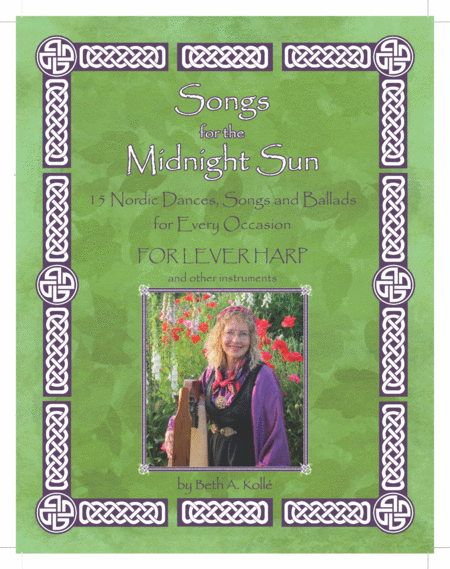Small Ensemble Flute,Harp,Violin - Level 3 - Digital Download SKU: A0.797341 Arranged by Beth Kolle. Concert,Folk,World. Score and parts. 40 pages. Afghan Press Music for the Harp #4808447. Published by Afghan Press Music for the Harp (A0.797341). Songs for the Midnight Sun comprises fifteen Nordic folk melodies, dance tunes, songs and ballads that have captured the arranger's imagination over the years. For Beth Kolle, Scandinavian music is the expression of the unparalleled beauty of the Nordic countries. The exotically different modes and harmonies evoke wild nature, and unseen beings of the ancient folk beliefs. This is music meant to be sung, danced to, or crooned to sleepy children, preferably in an age-old log cabin redolent of sweet, mellow resin and many years of comforting fires. As with all her other books, these arrangements are meant to be adjusted to your own playing style. Use them as a stepping-off point for making the arrangement your own, or use some of my ideas in a different song. Consider yourself warned: many Scandinavian tunes are addictive and tend to roll around in your head. The cure for that, of course, is to find another tune to replace the one in your head. And so on....good luck with that.Contains: Song from Venjan, Traditional Song, Dalarna, Sweden, The Dream, Gƶran āFreddyā Fredriksson, Sweden (also has flute/fiddle part), Polska from HƤlleforsnƤs, Traditional Polska, Sweden, Ball Polska, Traditional Polska, Sweden, Funk Fars Polska, Traditional Polska, RƤttvik, Sweden, Marjankukka (Berry Flower), Lauri Keskinen, Finland (Flute or Fiddle part included), Springtime Waltz, Traditional Waltz, Sweden (Flute or Fiddle included), Walking Tune (GĆ„nglĆ„t efter Hamare), Traditional GĆ„nglĆ„t, Sweden, The Lost Sheep, Traditional Melody, Telemark, Norway, Waltz from Denmark, Traditional Waltz, Denmark, Amanda, Roger Tallroth, Sweden ,Waltz from Folldal, Traditional Waltz, Norway (Flute or Fiddle part included), Bridal March from Ćppelbo, Traditional Wedding March, Sweden, Griffenfeldt, Traditional Reinlender, Norway, La Folia, Traditional Polska, Sweden (Flute or Fiddle part included)
